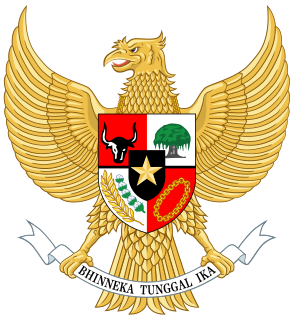
Since independence, Indonesian foreign relations have adhered to a "free and active" foreign policy, seeking to play a role in regional affairs commensurate with its size and location but avoiding involvement in conflicts among major powers. Indonesian foreign policy under the "New Order" government of President Suharto moved away from the stridently anti-Western, anti-American posturing that characterised the latter part of the Sukarno era. Following Suharto's ouster in 1998, Indonesia's government has preserved the broad outlines of Suharto's independent, moderate foreign policy. Preoccupation with domestic problems has not prevented successive presidents from travelling abroad.

Southeast Asia or Southeastern Asia is the southeastern subregion of Asia, consisting of the regions that are geographically south of China, east of the Indian subcontinent and north-west of Australia. Southeast Asia is bordered to the north by East Asia, to the west by South Asia and the Bay of Bengal, to the east by Oceania and the Pacific Ocean, and to the south by Australia and the Indian Ocean. The region is the only part of Asia that lies partly within the Southern Hemisphere, although the majority of it is in the Northern Hemisphere. In contemporary definition, Southeast Asia consists of two geographic regions:
- Mainland Southeast Asia, also known as the Indochinese Peninsula and historically as Indochina, comprising Cambodia, Laos, Myanmar, Peninsular Malaysia, Thailand, and Vietnam.
- Maritime Southeast Asia, also known as the Malay Archipelago and historically as Nusantara, comprising the Andaman and Nicobar Islands (India), Christmas Island and Cocos (Keeling) Islands (Australia), Brunei, East Malaysia, East Timor, Indonesia, the Philippines, and Singapore.
The foreign relations of Thailand are handled by the Ministry of Foreign Affairs of Thailand.

The Association of Southeast Asian Nations is a regional intergovernmental organization comprising ten countries in Southeast Asia, which promotes intergovernmental cooperation and facilitates economic, political, security, military, educational, and sociocultural integration among its members and other countries in Asia. ASEAN primarily objective was to accelerate economic growth and through that social progress and cultural development. A Secondary objective was to promote regional peace and stability based on the rule of law and the principle of United Nations charter. Whether some of the fastest growing economy is in the world asean broadened its objective beyond the economic and social spheres. In 2003, ASEAN moved along the path of EU by agreeing to establish an Asean community comprising three pillars namely the ASEAN security community the ASEAN economic community and the ASEAN socio -cultural community. In the asean logo the ten stalks (rice) represent the ten southeast Asian countries bound together in friendship and solidarity, the circle symbolises the unity of ASEAN

After the referendum on independence on 30 August 1999, East Timor became an independent nation on 20 May 2002 and began initiating foreign relations with the rest of the global community.

Papua New Guinea's foreign policy reflects close ties with Australia and other traditional allies and cooperative relations with neighboring countries. Its views on international political and economic issues are generally moderate. Papua New Guinea has diplomatic relations with 56 countries.

The Timor-Leste national football team is the national team of East Timor and is controlled by the Federação de Futebol de Timor-Leste. They joined FIFA on 12 September 2005.

The ASEAN Para Games is a biannual multi-sport event held after every Southeast Asian Games involving disabled athletes from the current 11 Southeast Asia countries. Participating athletes have a variety of disabilities ranging from spastic, cerebral palsy, mobility disabilities, visual disabilities, amputated to intellectual disabilities. The ASEAN Para Games is under the regulation of the ASEAN Para Sports Federation (APSF) with supervision by the International Paralympic Committee (IPC) and the Asian Paralympic Committee and is traditionally hosted by the country where the Southeast Asian Games took place.

The ASEAN Summit is a biannual meeting held by the members of the Association of Southeast Asian Nations (ASEAN) in relation to economic, political, security, and socio-cultural development of Southeast Asian countries. In addition, it serves as a prominent regional (Asia) and international (worldwide) conference, with world leaders attending its related summits and meetings to discuss various problems and global issues, strengthening co-operation, and making decisions. The summit has been praised by world leaders for its success and ability to produce results on a global level.

The East Asia Summit (EAS) is a regional forum held annually by leaders of, initially, 16 countries in the East Asian, Southeast Asian, South Asian and Oceanian regions, based on the ASEAN Plus Six mechanism. Membership expanded to 18 countries including Russia and the United States at the Sixth EAS in 2011. Since its establishment, ASEAN has held the central role and leadership in the forum. EAS meetings are held after the annual ASEAN leaders' meetings, and plays an important role in the regional architecture of Asia-Pacific. The first summit was held in Kuala Lumpur, Malaysia on 14 December 2005.
The ASEAN Common Time (ACT) is a proposal to adopt a standard time for all Association of Southeast Asian Nations member states. It was proposed in 1995 by Singapore, and in 2004 and 2015 by Malaysia to make business across countries easier. The proposal failed because of opposition in Thailand and Cambodia.

As of 2010, the Association of Southeast Asian Nations (ASEAN) has 10 member states, one candidate member state, and one observer state.

The Mekong–Ganga Cooperation (MGC) was established on November 10, 2000, at Vientiane, Laos at the First MGC Ministerial Meeting. It comprises six member countries, namely India, Thailand, Myanmar, Cambodia, Laos and Vietnam. The four areas of cooperation are tourism, culture, education, and transportation. The organization takes its name from the Ganga and the Mekong, two large rivers in the region.

The accession of East Timor to the Association of Southeast Asian Nations is a process that started following the independence of the country in 2002 when its leaders stated that it had made a "strategic decision" to become a member state of Association of Southeast Asian Nations (ASEAN) in the future. Closer ties with ASEAN are supported by all political parties in East Timor. East Timor would have by far the smallest GDP in the ASEAN, less than 15% of the smallest current ASEAN member state Laos.

The Southern Asia-Pacific Division (SSD) of Seventh-day Adventists is a sub-entity of the General Conference of Seventh-day Adventists, which coordinates the Church's activities in the nations of Bangladesh, Brunei, Burma, Cambodia, Indonesia, Laos, Malaysia, Pakistan, the Philippines, Singapore, Sri Lanka, Thailand, East Timor, and Vietnam. Its headquarters is in Silang, Cavite, Philippines. The Division has 1,523,695 members as of June 30, 2018
This article details the fixtures and results of the Timor-Leste national football team.

The Hassanal Bolkiah Trophy for ASEAN Youth Football Championship, is the football tournament for youth players in Southeast Asia. It was opened to football players from ASEAN member states under the age of 21 years to participate in this.

The possibility of accession of Papua New Guinea to the Association of Southeast Asian Nations is currently a matter of discussion.
The Timor-Leste–Indonesia–Australia Growth Triangle (TIA-GT) is a combined initiative of the regions of Eastern Indonesia, Northern Australia, and the Democratic Republic of Timor-Leste. This initiative aims to promote and foster economic growth through integrated economic development in the region that these nations reside in. The growth triangle was created in 2012, after a meeting was held by former Indonesian president Susilo Bambang Yudhoyono with former Prime Minister of Australia Julia Gillard and former Timor-Leste Prime Minister Xanana Gusmao. The initiative aims to support economic, social, and cultural development primarily by attracting investment, developing manufacturing industries, enhancing human capital, and overall building a stronger cooperative relationship between the three countries involved. The initiative also aimed to accelerate the accession of Timor-Leste into the Association of Southeast Asian Nations (ASEAN) and to fulfill goals set by Timor-Leste's Strategic Development Plan, such as increasing the nation's economic prosperity and stability. The growth triangle is often misinterpreted as a free-trade zone; however, while there are elements of free trade agreements between Indonesia and Australia specifically, the terms of the growth triangle initiative are not directly linked to these free trade agreements, and the goals of the growth triangle do not specifically encompass free trade between the three nations.


















